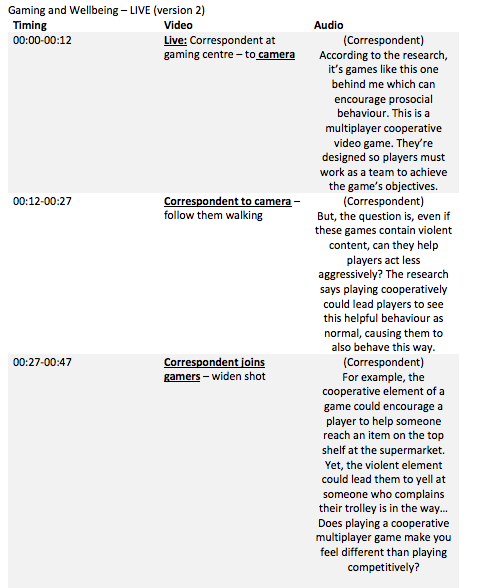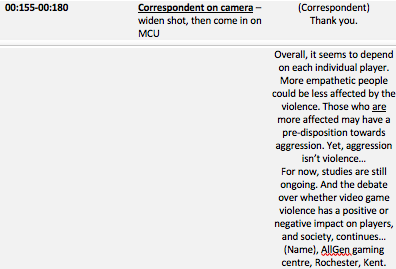Draft 2
Changes:
-Made it more personal to the group by adding in Michael's name.
-Had Michael state where he was and what he was going to do. By having a reporter try the games it turns their role into what Orlebar (2009:106) calls the 'elucidator', allowing us to visualise our concept in a way which will be absorbing to the audience. This is important because the audience need to connect with Michael as the reporter in order to trust his verdict once he has tried the games.
Improvements:
-Could be improved by having an expert instead of only a gamer in the video game violence and behaviour package, since this would add more authority, which is needed since the source material we are drawing from is scientific research.
-Separate the studio and live script.
Draft 3
Studio-
Changes:
-Self-contained, so the show now has its own opening and ending, similar to that of BBC Click.
-Gaming disorder comes first, however it isn't the top story. The new development in the video game violence and behaviour debate is more relevant to our audience, because the debate has been going on for so long.
Improvements:
-Needs reordering so video game violence and behaviour is the top story, since this development is part of a long, and important debate.
Live-
-When writing a package script, 'The writer has to consider both what the viewer sees (visuals) and also what they are going to hear (audio)' (Halbrooks, 2018), which is why two columns are needed, as well as timing so that when filming nothing overruns.
-Visuals and audio which compliment each other are therefore vital, since they are able to convey to the audience 'what is happening, where, to whom and by whom, and why it is important' (Orlebar, 2009:107). This is why I decided to have the correspondent interview an expert whilst playing one of the games. However, on re-reading the script, playing the game could make it difficult for the correspondent to interview the expert, and take away the focus from how the game is affecting the correspondent's behaviour, which is the point of them trying the game.
Two-way live
Because our news channel is aimed at young people, a two-way live could have worked since they can represent a more conversational and informal tone (Cushion, 2015:103). However, the problem it caused was that it meant all of the information in the report was told, rather than shown. Again, it took the focus away from trying the games and comparing behaviour.
Draft 4
Studio-
Live-
Changes:
-To sync the live with the studio more, this studio script cuts to the live, goes to a different story, then comes back to the live. However, this was confusing, since cutting to the live for not very long didn't reveal any information about the story.
Improvements:
-Since, according to Orlebar (2009:112), commentary, 'should add information, comment or, in certain cases, opinion', it would be better to cut going to the live before going into the gaming disorder story, and instead divide them into two separate segments.
-It would be better if the gamer gave their opinion after trying the games, because then the audience can see what they are giving their opinion on, and will have built trust that this gamer has played these games so has seen how they affect their behaviour.
-It would be better if the gamer gave their opinion after trying the games, because then the audience can see what they are giving their opinion on, and will have built trust that this gamer has played these games so has seen how they affect their behaviour.
Draft 5
Studio-
Live-
Changes:
-Cutting straight to the live, and using a pre-recorded report to lead into the live interview makes the piece have what Vin Ray calls better 'singularity' - telling only one story at a time, and 'stream' - since transitional words, such as 'and', 'but', and 'so' allow the different stories and each of their points to flow into each other (Orlebar, 2009:112). This is important for these stories because they are both new, so need to be introduced to the audience clearly, as well as fit together in the one news bulletin.
-Using pre-recorded footage for the game tests with the correspondent and gamers also allows for a variety of footage to be cut into the report, which can cover how the games affect all the gamer's behaviours. It also allows for the comparison between competitive and cooperative games, which is necessary since it will further emphasise how cooperative gaming should make players less aggressive than competitive gaming by allowing the audience to see the difference themselves, so they could draw up their own conclusions.
-Interviewing a university tutor of game design also adds an expert opinion, since they have experience designing and playing video games, so can tell us about the thought processes involved in making decisions regarding how much violence goes into these games, adding needed authority to the report.
-Adding the shots on the video side make it easier to visualise what we will film, and help to remember that, 'A typical interview starts with an MS and changes to an MCU during the first or second question; it then goes to the CU for question three', coming in on the subject when they say something especially important or relevant (Orlebar, 2009:109).
-Adding the shots on the video side make it easier to visualise what we will film, and help to remember that, 'A typical interview starts with an MS and changes to an MCU during the first or second question; it then goes to the CU for question three', coming in on the subject when they say something especially important or relevant (Orlebar, 2009:109).
Improvements:
-Assign a studio reporter and a correspondent, and add their names, as well as the name of the show and the contributors.
-Consider branding so that the tone and style of the script fits with the rest of our news channel.
-Think about the questions for the game designer, since this is a sensitive area of debate.
Final drafts
Studio-
Live (Plan A)-
Live (Plan B)-
Changes:
-Made a plan B for the live segment, in case the contributor didn't show up or couldn't make it since our live shoot kept moving around
-Considered branding, and made 'we investigate' an integral part of ours, since our channel specialises in investigating technology with reporter tries segments, and headlines from the studio, which these scripts reflect
Improvements:
-Cut the live plan B to two minutes rather than three to keep it within the assigned time limit laid out in the brief
Reshooting the live
Changes:
-Added more action -- this was important since it was very static as only the interview before, with the presenter having to give a lot of information to the camera all at once.
-Cut down the live interview so that it lasts for just over a minute and a half. This gives our contributor extra time to answer if needed.
-Planned the contributors and knew they would definitely be there before writing the script. The script changed so many times because we weren't sure if contributors were going to commit to the project, and some didn't turn up like we expected so the plans had to keep changing.
-Used less jargon and tried to write in shorter sentences. This is important since the presenter was more likely to remember the lines and not run out of breath (Morrison, 2007). This information could be broken up more effectively and conveyed by the contributors rather than only the presenter.
Next time:
-Get the presenter to practise the script more and make time to get feedback from the whole crew (Morrison, 2007). I found with these scripts I was making adjustments on my own instead of getting the group's opinions because everything was changing so quickly. The script could have been better if I had got a detached opinion on it.
-The writing could have been improved by hearing the presenter saying it out loud before filming since then I would have realised some of the sections were too long and didn't communicate the information to the audience as well as they could have done.
Bibliography
Cushion, S. (2015). News and Politics: The Rise of Live and Interpretative Journalism. Oxon: Routledge.
Halbrooks, G. (2018) News Packages for TV Newscasts. At: https://www.thebalancecareers.com/what-exactly-is-a-news-package-for-a-tv-newscast-2315185 (Accessed on 7 October 2018).
Morrison, E. (2007) 'Presenting tips from a BBC voice coach'. In: BBC News [online] At: http://news.bbc.co.uk/1/hi/school_report/7062241.stm (Accessed on 27 October 2018).
Morrison, E. (2007) 'Presenting tips from a BBC voice coach'. In: BBC News [online] At: http://news.bbc.co.uk/1/hi/school_report/7062241.stm (Accessed on 27 October 2018).
Orlebar, J. (2009) 'Writing, editing and packaging for television' In: Chapman, J. (ed.) and Kinsey, M. (ed.) Broadcast Journalism: A Critical Introduction. Oxon: Routledge. pp.105-113.



























Comments
Post a Comment